The Puffin Project
Air Date: Week of May 15, 2015
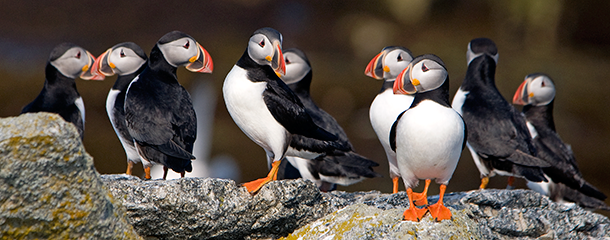
Puffins gathering on a rock (Photo: Derrick Jackson)
When National Audubon Society Vice President Steve Kress first began his quest to restore the historic puffin population on a small island off the coast of Maine, he had no idea it would become his life’s work. That journey is the subject his new book called Project Puffin, co-written with Boston Globe editor Derrick Jackson. Kress describes the long and difficult process to host Steve Curwood, and discusses how some of the lessons he learned could help conservationists trying to protect other bird species.
Transcript
CURWOOD: It's Living on Earth. I'm Steve Curwood. Environmental success stories are favorites here at Living on Earth. So we were excited to read a new book called "Project Puffin: The Improbable Quest to Bring a Beloved Seabird Back to Egg Rock". One of the book's co-authors and photographer is Boston Globe editor and columnist Derek Jackson.
JACKSON: It’s pretty funny for me because I started off as a sports writer, and so once upon a time the only birds I knew about were the Atlanta Hawks, the Philadelphia Eagles, St. Louis Cardinals and Baltimore Orioles. But because my wife's an outdoor person I got into the outdoors and I heard about these puffins, and at that time the success of it was only five years old so it was still pretty exciting to be at a place where life that had been lost had been restored.
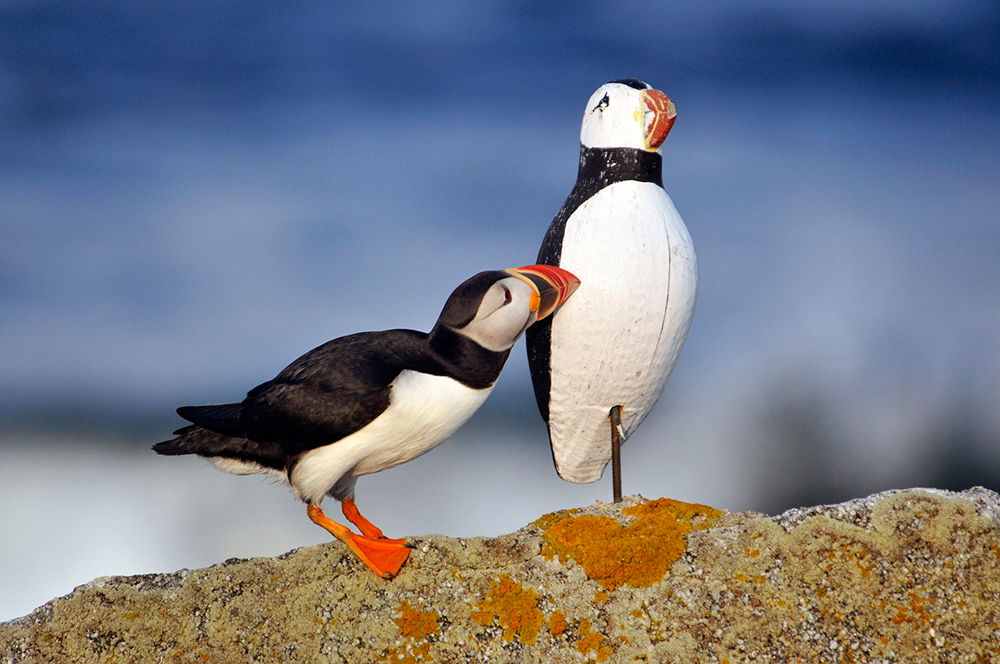
A puffin inspecting one of the decoys set up by Kress’ team (Photo: Derrick Jackson)
CURWOOD: That restoration was the work of the book's other co-author, Steve Kress. Steve is the vice president of the National Audubon Society, and since his early 20s he has been working to restore the historic puffin population to Egg Rock off the coast of Northern Maine. Steve says his devotion to the puffin was rooted in a childhood spent close to the birds and bees.
KRESS: As a kid I was fortunate in meeting ornithologists and other birders and they shared their passion and enthusiasm with me and I caught the bug of just enjoying being out in nature. It started with non-birds. It started with lizards actually. The blue-tailed skink was my greatest of prizes as a child, but any frog or turtle, or reptile; anything that I could actually get my hands on was terrifically interesting. So yeah, that's how it all started. And then it just sort of stuck from there. I just kept meeting more people and realizing there was a relatively small world of birders out there and there's so much interconnection and all pathways sort of pointed me toward Hog Island which is sort of where ornithology had its beginning in the northeastern United States.
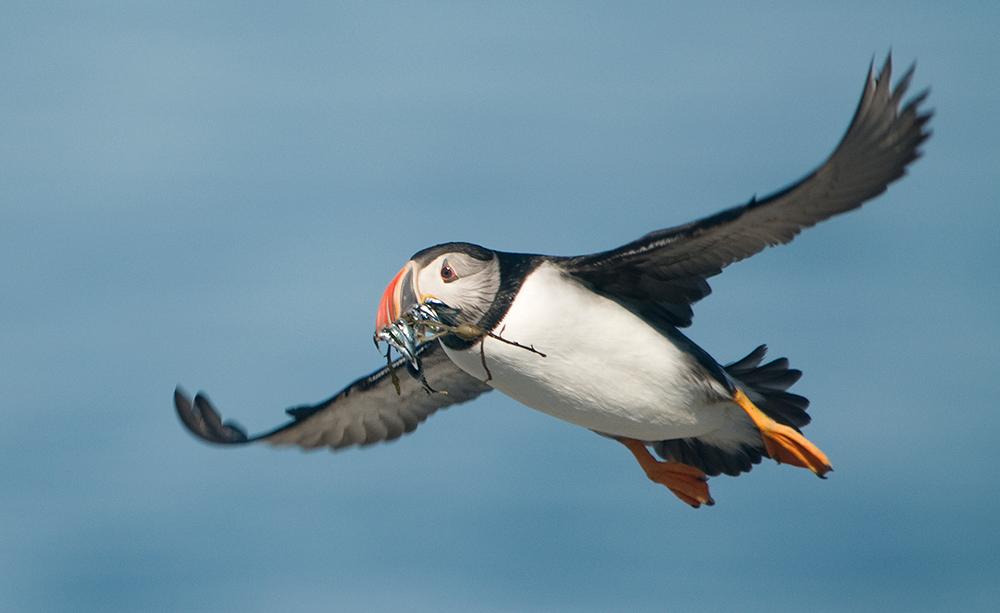
Flying with fish (Photo: Derrick Jackson)
CURWOOD: How's that?
KRESS: Well there’s this beautiful island, a 330-acre pristine island, spruce covered island, offshore near Damariscotta, Maine, where Roger Tory Peterson, the sort of undisputed father of birding in United States was the first bird instructor. Alan Cruickshank another famed early American birder and others have followed and they just sort of started a tradition of people coming there and learning about birds. I started working at the Audubon camp in 1969 and learned that puffins once bred about eight miles from where I was working on Hog Island, and once I've discovered those islands were once home to puffins, I couldn't see them the same as I used to. I saw them as places that were devoid of life rather than full of life. It was a strange twist of perspective, but once I realized that they were a diminished place I began setting out to try to bring them back. I didn't know that I would be at this for decades. When I started this I thought, oh, this will take a few years and I'll be on to something else, but I guess hasn't worked out that way.
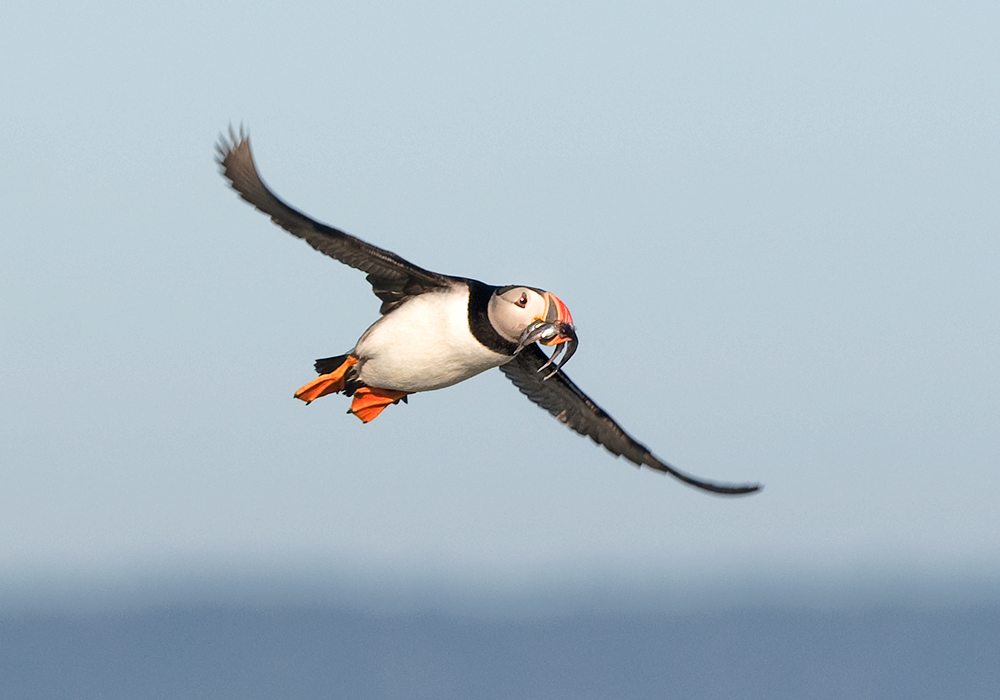
Puffin flying with fish (photo: Derrick Jackson)
CURWOOD: [LAUGHS] I guess not. So what did you think you could restore these Puffins to the places that they had been hunted off almost a century before?
KRESS: The idea of bringing the puffins back probably was influenced by other bird conservation projects at the time, notably the Peregrine Fund was starting its work at Cornell trying to reestablish the Peregrine falcon, a bird that had disappeared because of the use of DDT. It was still a novel idea and many people at the time felt that it was better just to let nature to take its course, and the species that would best adapt to living with humanity would be the ones that would be the future co-inhabitants of the planet and if we lose some on the way they were the ones that just didn't fit anymore.
CURWOOD: And I suppose this philosophy struck you with – let’s see, who cohabitates with people best - roaches, rats - things that we don't particularly like.
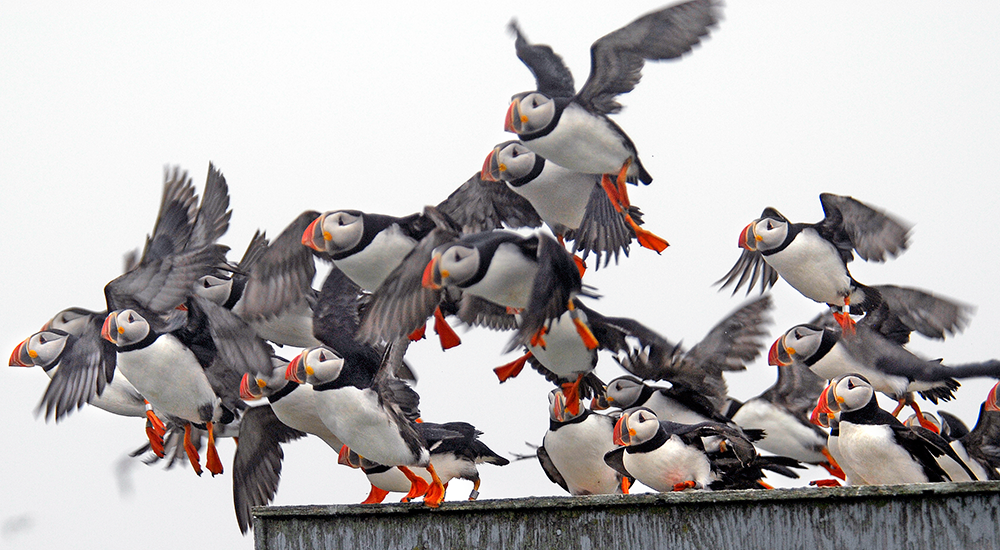
Taking flight as one (Photo: Derrick Jackson)
KRESS: So, I've come to realize that the species that benefit the most from people tended be scavengers and, yes, the species that seemed to do the best of them are often considered nuisance species by people. In the bird word that would include lots of native birds, not just introduced species but natives like gulls, herring, and blackback gulls would be the most obvious example of that along the Maine coast, scavenging behind fishing boats and in garbage dumps. So if that was the pattern then we were going to lose birds like the puffins and there was nobody out there really trying to help these specialized species especially if they were not an endangered species. Endangered birds had a certain cachet just in their rareness, but common species, not necessarily. Especially species that were still nesting in the millions, and the puffin was among those. You could find millions of them if you would just travel to Iceland and some would say to me: “why should you bother to restore a common species when if people want to see them, they should just go to Iceland”. I felt that we had lost them on the Maine coast; perhaps it was the proper thing to do to bring them back.
CURWOOD: Now, you got to say if you look at a puffin, it's hard not to - come on – laugh! They're roly-poly, they have this brightly colored beak, they stand up directly - they almost look like a penguin - and they're charming, right?
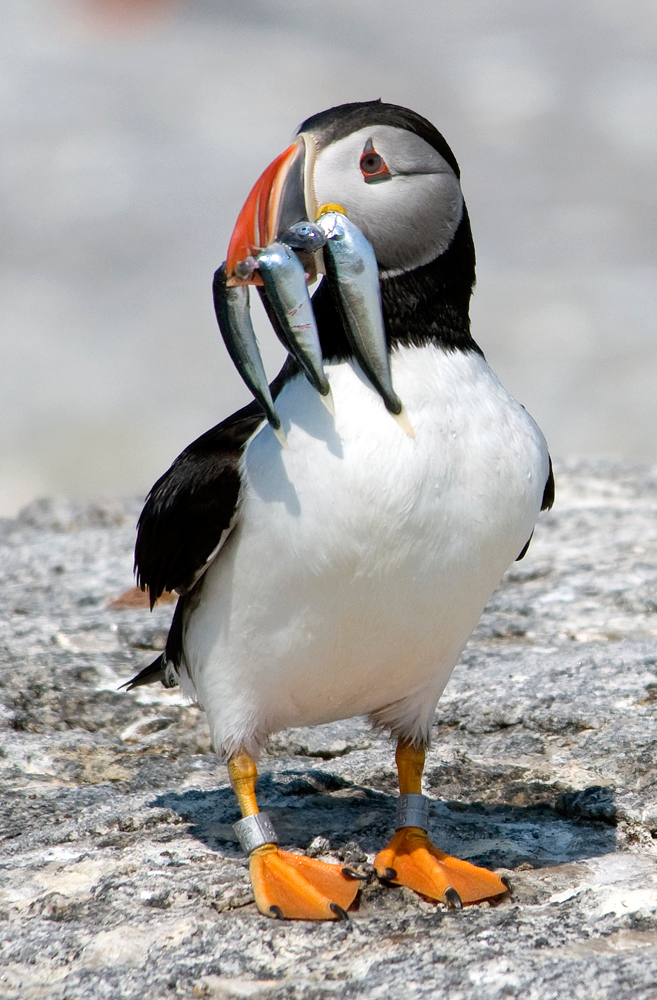
Puffin with bands on its legs (photo: Derrick Jackson)
KRESS: Puffins are a charming bird. They kind of are caricatures of the human form. They're upright. They stroll. They waddle back and forth and they have this comical face, clown-like face, so yeah, they are sort of built-in endearing. Of course it's all functional from their point of view. They're feet are all way back because they're used as rudders underwater and they have those short wings they hold to their sides because they use them as flippers underwater. It's all about function. But it also happens to characterize a human clown like form which people love.
CURWOOD: And you in particular really, they sucked you right in, of all birds you could've chosen to devote your life to - although I gather you didn't know it was going to turn out to be a lifelong exercise - I mean, are there any that are cuter than this?
KRESS: I don't think there's any that are cuter than a puffin. [LAUGH]
CURWOOD: So you decided at age 20 that you are going to figure out a way to save these birds to bring them back to this place where they had been. How did you just start?
KRESS: I started the idea of bringing puffins back by learning as much as I could about them. A few things I learned was that was that puffins just lay one egg. They don't usually lay it until they're several years old and then interestingly enough at the end of the breeding cycle which is about six weeks long the chicks head off to sea by themselves not with parents which is very helpful to me in my plan because there's no way I was going to follow these chicks to sea. But the key part of the story was that they learned were home was while they were at the island. My hope was that I could find puffin chicks that were impressionable and that I could move them before they learn where they were hatching, hand-rear them, release them and give them the two to learn about the release site, the new home. That method is called translocation now and it's widely used, but at the time it was never used before for a seabird.
CURWOOD: So where can you get extra spare baby puffins?
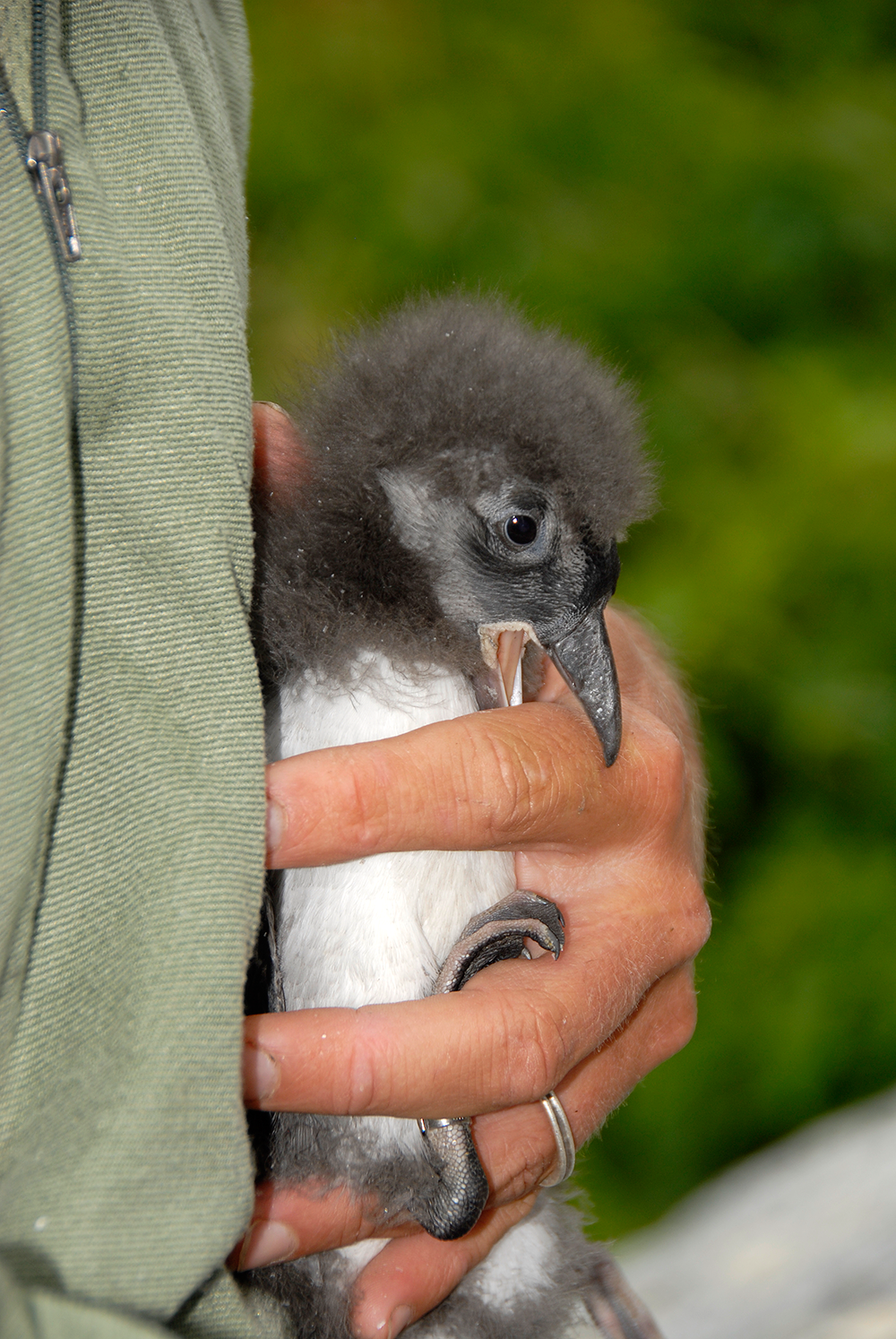
Feisty puffin chick in hand (Photo: Derrick Jackson)
KRESS: Fortunately there are still large colonies of puffins in Canada and I had to travel all the way to Great Island Newfoundland. And with the cooperation of the Canadian Wildlife Service, and with their help out, we climbed down the cliffs of the Great Island where at the time about 160,000 pairs of puffins. It was an awesome site. We moved as many as 200 of them at a time.
CURWOOD: And how do you move a baby puffin?
KRESS: You pick it up, take it out of its burrow, put in a specially built carrying case and as fast as you can you bring it back to Maine.
CURWOOD: I would imagine ma and pa puffin weren't too thrilled about this.
KRESS: When you reach into a puffin burrow you have to be careful because if the parent puffins are in there, that big colorful cuddly looking beak is actually quite a crusher and if they grab ahold of your finger and start twisting and shaking with their raptor like hook which they have it can be damaging. But we did it and we reached into enough puffin burrows and we obtained enough puffins to bring them back. We tried not to revisit the same puffin burrow in more than one year; so that we didn't have the same ongoing disturbances same parent puffins. And most of the chicks survived we brought from Newfoundland. They are very hardy little birds. They trucked off to sea with our bands and disappeared in the darkness.
CURWOOD: You brought hundreds of birds from Canada to Egg Rock Island where you hoped to get a new puffin colony but, how would you know you had succeeded?
KRESS: The only way we would know whether we were having success was see the puffins come back and we put leg bands on them before they fledged, that's before they left the island, so we would recognize them in the future. A metal band on one leg and usually a color band, a plastic band on the other leg, and then we just had to sit out there and wait. And the thing is that we had to wait four years without seeing anything at all. Four years into the project, we had released several hundred puffins and none of them had come back. I was starting to get questions from the supporters; the providers of the puffins, and the Canadian Wildlife Service were wondering what is going on. When are you going to have some success? I asked for patience - no one's ever done this before - we have to see this out because if we fail at this other people in the future probably won't want to try something similar. And there's a great need. Even then I knew there were many rare seabirds would benefit from this project if we could prove success.
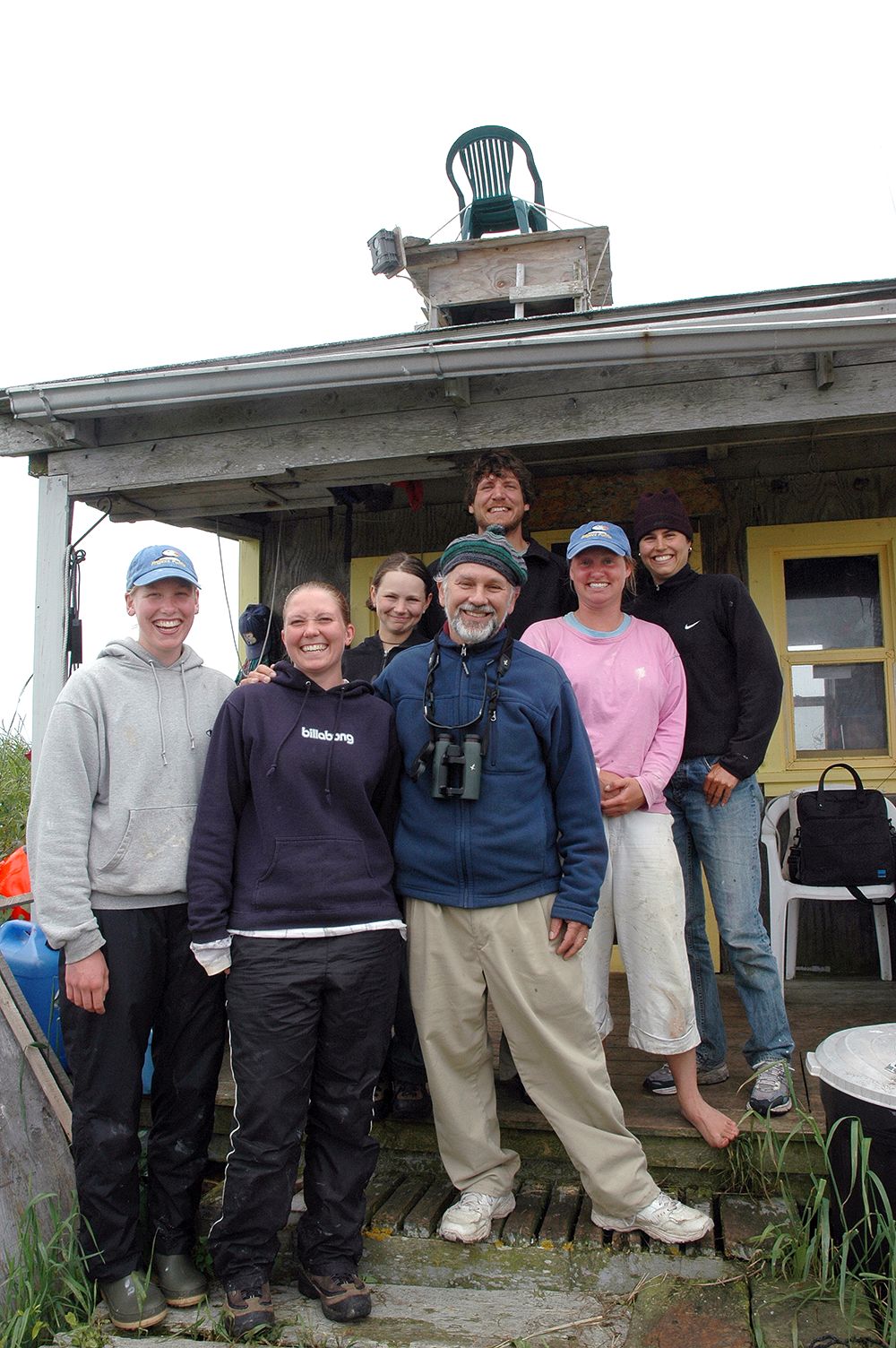
Steve Kress and students in Maine (Photo: courtesy of Stephen W. Kress)
CURWOOD: So big goose egg so far – or maybe big puffin egg so far. But no birds back so this is the point that you're about to give up but by the title of your book obviously you didn't. What happened?
KRESS: In four years we needed to have some success. I began trying to think like a puffin and I realized that one of the things that were missing was the fact that there were no other puffins on the island. Puffins are social birds. They nest in colonies. And a young puffin coming back even if it did remember Egg Rock might not come ashore without the sight of other puffins, so I came up with the idea of using decoys. So we got some decoys specially made, specially carved, not something you can buy off the shelf any place, put some in the water, put some on land and we didn't have to wait very long before one showed up. Within days there was a puffin that landed on the island, and then it landed with the decoys on land, and it had our leg bands. I was so excited.
CURWOOD: So puffins like a party huh?
KRESS: Puffins don't like to be alone. They like other puffins. Now puffins do land with decoys we discovered and they'll pick at the beak and they'll pick at the belly and eventually they will get bored. They'll leave. Because they're not getting much response and they're not really fooled by the decoy for long, but I decide to put out mirrors, boxes with mirrors on all sides, and the puffins would land with the decoys then they would waddle to see the reflection in the mirror and they would just sit there and look at themselves and they move a little bit, the reflection would move. I don't think they really were totally fooled by this to think it's another puffin but what did happen was that other puffins would land with the puffins that were sitting among the decoys and the mirrors and eventually we start seeing more and more puffins sitting on the island.
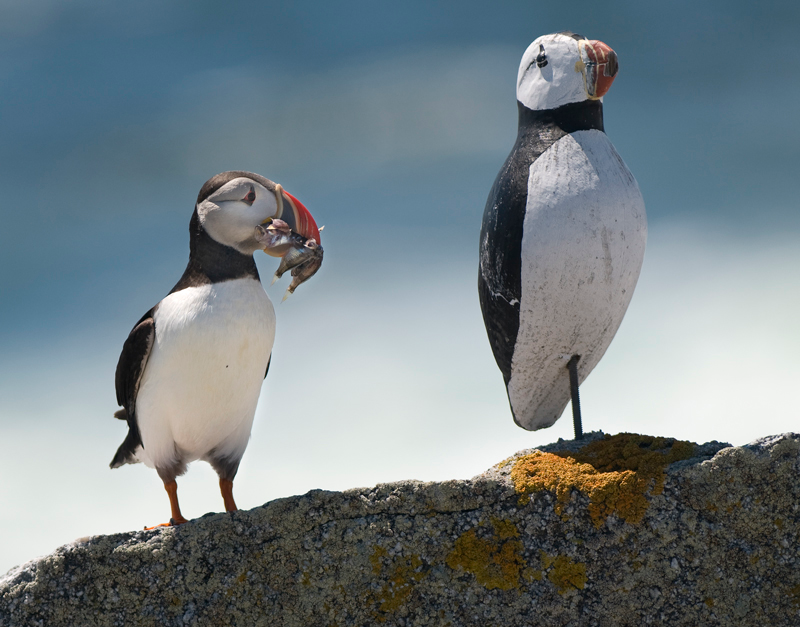
Checking out one of the decoy puffins (Photo: Derrick Jackson)
CURWOOD: So you've created a puffin party by having models. That always helps a party scene. You have a mirror ball that helps the party scene. But what about the sound?
KRESS: We didn't use sound for puffins, recorded sound. Later when I started attracting terns I started using recorded sounds for terns and that has proved to be very attractive from the terns. With puffins I was trying to keep it simple and with puffins they're not that loud. They don't call a lot, especially at that stage in their lifetime. Later in life they have a deep growling call. It sounds sort of like this. [NOISE] That's a call between a mated pair but the prospecting birds, these young birds, they don't call much, so we want to try to keep it as simple as we could. And the mirrors, the decoys, they started coming back, but they still weren't breeding. We were eight years into this project, still no nesting.
CURWOOD: So what do you do then? If these birds are propagating themselves you're going to be bringing chicks from Canada forever.
KRESS: And even a greater concern was that some of our birds brought from Canada started nesting at a nearby puffin colony Matinicus Rock.
CURWOOD: Traitors.
KRESS: I was worried that they would move over there after all my efforts—so close but so far. Eight years into the project, the critics were really becoming increasingly vocal at that point, that this had not worked, stop spending money on it, stop saying that it's working. We still needed birds breeding and that's why in 1981 on the fourth of July when we saw the first puffin flying in with fish, that's the clue we were looking for, and finally we had success at Egg Rock.
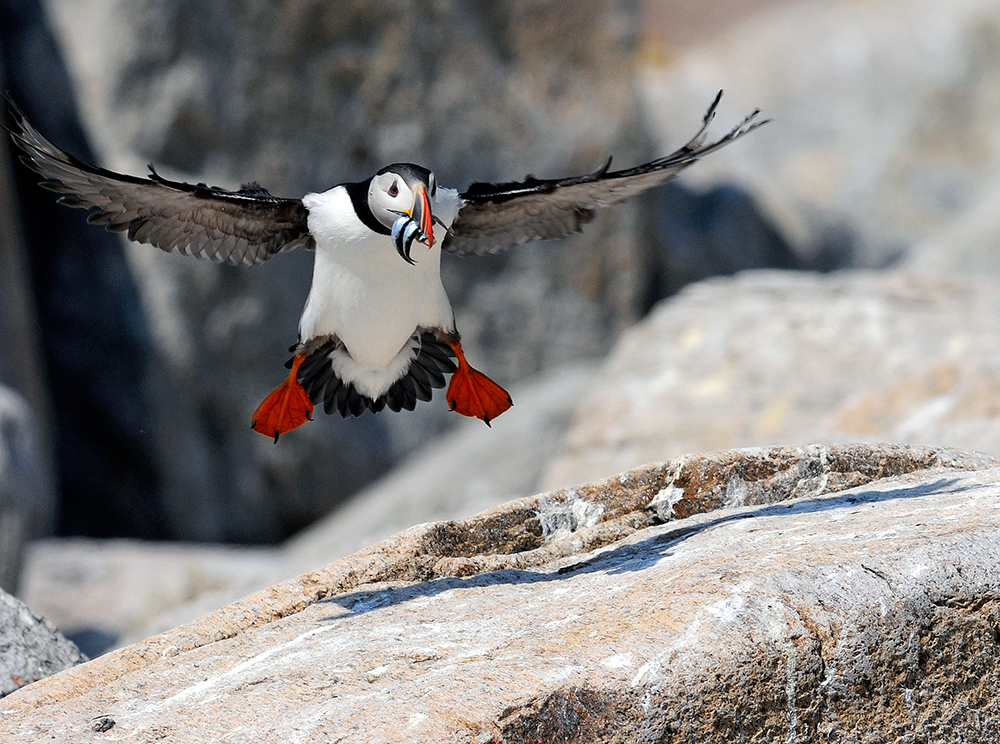
Coming in for a landing (Photo: Derrick Jackson)
CURWOOD: Flying in with fish to...
KRESS: Feed its chick. Fly in with fish and drop under the rocks and they come out without the fish, and that's the sign we're looking for. That meant there was a puffin chick under the rocks, the first puffin chick in nearly 100 years.
CURWOOD: Steve, a number of people have emulated the techniques you developed on the puffin project, there are a number of bird restoration projects around the world, and in your own book, you can wrestle with the question of sustainability. You say that people ask you how sustainable is this, and your answer is that's maybe not the right question. So what is the right question and what's the right answer?
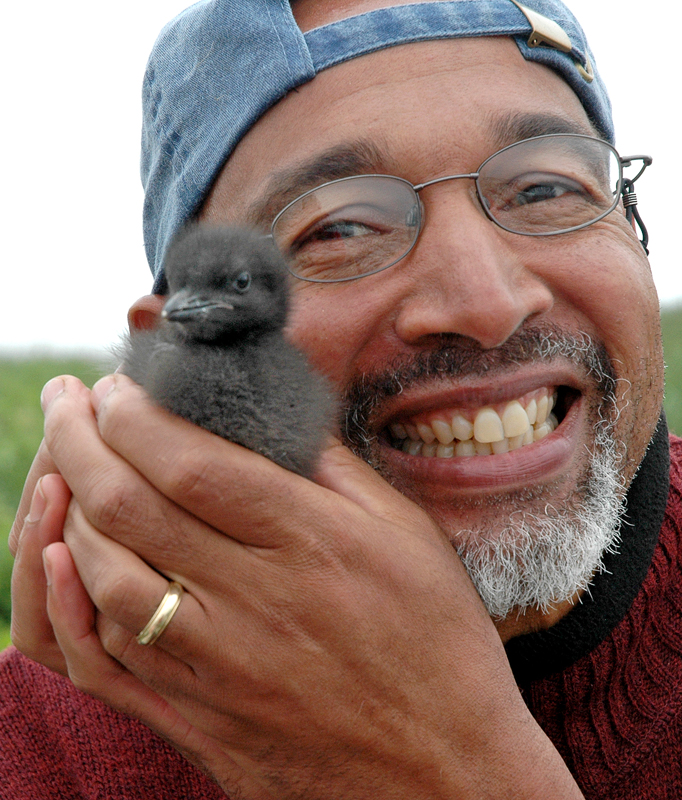
Derrick Jackson and a guillemot chick (photo courtesy of Stephen W. Kress)
KRESS: Project Puffin is showing that if you just don't do this kind of work these species are not going to come back. To stop this kind of work they probably still will disappear, but they are still capable of living in this environment with a helping hand. When I was a young man, one of my mentors, Duryea Morton pointed out to me that people are the only species that can make other animals go extinct. People therefore have an opportunity, perhaps even an obligation, to be the only species that can help sustain life on Earth, because if we stop, these species that have been affected by humans will disappear. We live in a time of extinction, and without active intervention we can be sure that we will lose species, and if we do future generations will not have the opportunity to do the restoration that we have today.
CURWOOD: Steve Kress and Derek Jackson are co-authors of the book: "Project Puffin: The Improbable Quest to Bring a Beloved Seabird Back to Egg Rock". Steve, thanks for taking the time today.
KRESS: My pleasure.
Links
Puffin Project: The Improbable Quest to Bring a Beloved Seabird Back to Egg Rock
Living on Earth wants to hear from you!
Living on Earth
62 Calef Highway, Suite 212
Lee, NH 03861
Telephone: 617-287-4121
E-mail: comments@loe.org
Newsletter [Click here]
Donate to Living on Earth!
Living on Earth is an independent media program and relies entirely on contributions from listeners and institutions supporting public service. Please donate now to preserve an independent environmental voice.
NewsletterLiving on Earth offers a weekly delivery of the show's rundown to your mailbox. Sign up for our newsletter today!
 Sailors For The Sea: Be the change you want to sea.
Sailors For The Sea: Be the change you want to sea.
 The Grantham Foundation for the Protection of the Environment: Committed to protecting and improving the health of the global environment.
The Grantham Foundation for the Protection of the Environment: Committed to protecting and improving the health of the global environment.
 Contribute to Living on Earth and receive, as our gift to you, an archival print of one of Mark Seth Lender's extraordinary wildlife photographs. Follow the link to see Mark's current collection of photographs.
Contribute to Living on Earth and receive, as our gift to you, an archival print of one of Mark Seth Lender's extraordinary wildlife photographs. Follow the link to see Mark's current collection of photographs.
 Buy a signed copy of Mark Seth Lender's book Smeagull the Seagull & support Living on Earth
Buy a signed copy of Mark Seth Lender's book Smeagull the Seagull & support Living on Earth

